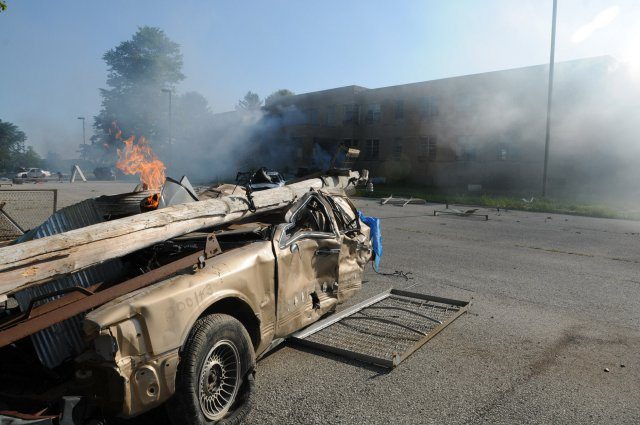More than 7,000 Soldiers, Sailors, Airmen, Marines and Department of Defense civilians are descending upon the Muscatatuck Urban Training Complex at Camp Atterbury, Ind., and various surrounding areas in Indiana, to execute DoD support to civil authorities in a consequence management role during the Vibrant Response 12 exercise.
The exercise is conducted by U.S. Army North and is the command’s largest disaster response exercise to date. The multi-agency, multi-component exercise is intended to prepare federal military forces for their role in responding to a catastrophic chemical, biological, radiological or nuclear, or CBRN, incident in the homeland.
During the exercise, members of the 51st Weapons of Mass Destruction Civil Support Team, or CST, Michigan Army National Guard, simulated rolling out of Cincinnati when they notionally observed the flash and felt the rumble of a simulated nuclear blast Aug. 16. A call came over the radio telling them to turn around, head back into the simulated incident area and to monitor radiation along a route that police and firefighters would use.
Speakers in training area blared safety messages for residents. “This is an urgent message from the Ohio Emergency Management Agency. This is not a test. Officials confirm that a nuclear explosion has occurred in the Cincinnati area. Police and firefighters are on the ground and more help is coming.”
The Guard team pulled in front of a large building billowing smoke and began pulling equipment out of trailers and compartments. People milling about demanded information and begged for medical aid and water from the team.
“Are we under attack?” a bystander asked a team member. “Help us, please.”
Except that Cincinnati was actually the Muscatatuck Urban Training Complex in southern Indiana, and the “victims” of the simulated 10-kiloton nuclear detonation were actually role players, in various degrees of garb, simulating injured citizens during the initial phase of the exercise.
“The scenario tests responding forces from the military and how they work together to save lives, relieve suffering and mitigate great property damage,” said Vince Sharp, observer controller trainer, Army North.
“If this ever happens in a real world event, said Staff Sgt. Chad Francisco, survey team chief, 51st CST. “We’ll be prepared for the worst-case scenario, but I hope we never have to do it.”
CST members cleared a route for local responders and reported on the area for members of the nation’s Defense CBRN Response Force, or DCRF, a force of 5,200 DoD personnel.
During the exercise, the DCRF is scheduled to conduct numerous missions, to include decontamination, medical treatment and evacuation as well as logistical missions to transport food, water and supplies to victims. The exercise, scheduled for Aug. 16-28, will also challenge the participants in other key tasks, such as setting up communications and clearing debris from roadways.
Members of the Federal Emergency Management Agency, and local and state emergency responders, are also participating in the exercise.










